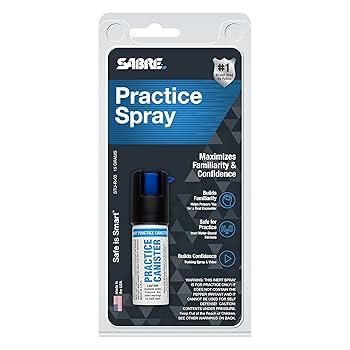Table of Contents
- Training Safety Elevated through Innovative Inert Practice Sprays
- Detailed Analysis of Risk Reduction Benefits in Training Environments
- Best Practices for Integrating Inert Sprays into Safety Protocols
- Expert Recommendations for Maximizing Training Effectiveness and Safety
- To Conclude
Training Safety Elevated through Innovative Inert Practice Sprays
Inert practice sprays have rapidly become a cornerstone for advancing safety protocols within professional training environments. By simulating real-life scenarios without the hazards associated with live agents, these sprays offer unmatched protection for trainees and instructors alike. Their chemical formulation is designed to be non-toxic and non-irritating, allowing for repeated use in confined spaces without compromising health standards. This innovation significantly reduces the risk of accidental exposure to harmful substances, fostering a controlled yet realistic training atmosphere.
Beyond safety, inert practice sprays enhance the effectiveness of training sessions by introducing a tangible yet safe sensory element. Users benefit from:
- Realistic feedback that mirrors the behavior of actual operational agents
- Improved muscle memory through consistent, safe repetition
- Lower operational costs due to reduced need for specialized protective equipment
- Environmental sustainability as these sprays avoid the release of harmful chemicals
As agencies and organizations prioritize comprehensive safety standards, the integration of inert practice sprays into regulatory training regimes is rapidly becoming industry best practice, setting new benchmarks for responsibility and efficiency.
Detailed Analysis of Risk Reduction Benefits in Training Environments
Integrating inert practice sprays into training scenarios has revolutionized safety protocols by effectively eliminating the hazards associated with live agents. These sprays replicate real-world conditions without the risk of exposure to harmful chemicals, thereby significantly reducing the chance of accidents or injuries. Trainees gain hands-on experience with authentic equipment feedback, fostering confidence and skill development in a controlled, risk-free atmosphere. This modern approach not only protects personnel but also promotes a culture of safety awareness essential for high-stakes environments.
Beyond immediate injury prevention, the use of inert sprays carries substantial operational advantages. Training centers benefit from:
- Lower operational costs by minimizing the need for expensive safety gear replacements and decontamination procedures.
- Extended equipment lifespan as inert substances cause no wear or residue buildup, unlike their active counterparts.
- Improved regulatory compliance by adhering to stringent occupational health and safety standards.
Together, these factors contribute to a comprehensive risk management framework that enhances overall training effectiveness and readiness.
Best Practices for Integrating Inert Sprays into Safety Protocols
To achieve optimal results when incorporating inert sprays into safety training, organizations should establish clearly defined guidelines that align with existing emergency response protocols. Begin by designating specific scenarios where inert sprays can safely simulate hazardous conditions without compromising participant safety. Training facilitators must be thoroughly educated on the chemical properties and operational mechanisms of the sprays to ensure accurate demonstration while preventing misuse. Furthermore, regular maintenance and storage checks of the inert spray equipment help guarantee reliability and readiness during training exercises.
Embedding these sprays into multi-layered training drills helps trainees build confidence in handling real-life emergencies by experiencing realistic, hands-on practice in a controlled environment. Key considerations include:
- Clear communication: Inform all participants beforehand about the use of inert sprays to avoid panic or misunderstandings.
- Safety oversight: Assign supervisors to monitor exercises continuously and intervene if any safety risks emerge.
- Feedback integration: Collect immediate trainee feedback to refine protocols and address any uncertainties.
Integrating these practices cultivates a culture of preparedness and ensures that the use of inert sprays enhances overall training efficacy without detracting from safety standards.
Expert Recommendations for Maximizing Training Effectiveness and Safety
To ensure training sessions are both impactful and safe, it is crucial to integrate inert practice sprays as a standard tool for simulation exercises. These sprays allow trainees to develop muscle memory and critical response skills without the risk associated with live agents. Experts advise conducting drills in controlled environments where trainees can focus on precision, timing, and decision-making while minimizing anxiety and exposure to harmful substances.
- Repetition in Realistic Scenarios: Encourage frequent use of inert sprays in scenarios that mirror real-life situations to elevate confidence and competence.
- Implement Safety Protocols: Ensure all participants understand the importance of standard safety measures, including proper handling and personal protective equipment.
- Feedback Loops: Incorporate structured debrief sessions after each exercise to analyze performance and reinforce best practices.
Additionally, integrating technology such as video analysis or sensor-based feedback can significantly enhance the learning curve. This allows trainers and trainees to identify subtle mistakes and correct technique in real time. By prioritizing safe practice with inert sprays and a comprehensive training framework, organizations can foster preparedness, reduce risks, and ultimately improve overall operational effectiveness.
To Conclude
In conclusion, the integration of inert practice sprays marks a significant advancement in training safety protocols across various industries. By minimizing the risks associated with live substances, these sprays allow trainees to build confidence and competence in a controlled environment. As organizations continue to prioritize safety without compromising the quality of instruction, inert practice sprays are poised to become an essential component of effective and secure training programs worldwide.Check Our Other Blogs
- StunGun – Your Trusted Source for Stun Guns, Laws, and Self-Defense Tips
- PepperSprayLaws – Your Trusted Resource for Pepper Spray Information
- StunGunLaws – Your Trusted Guide to Stun Gun Legality and Safety




